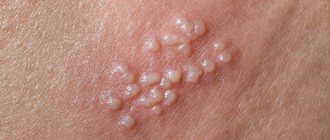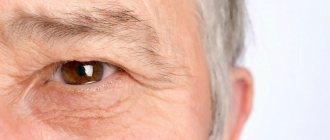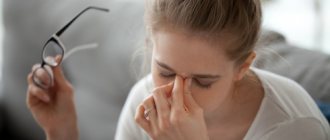Neurologist (algologist)
Vasilenko
Marina Gennadievna
25 years of experience
Head of the Pain Treatment Center, neurologist-algologist, member of the Society of Neurologists and Neurosurgeons, Russian Society for the Study of Pain, Association of Interdisciplinary Medicine, International Association for the Study of Pain (IASP)
Make an appointment
Occipital neuralgia is a disease of neurological origin, which is associated with irritation of the nerve roots in the occipital region. The pathology affects pairs of spinal nerves: the lesser and greater occipital nerves. The inflammatory process compresses and irritates these nerves, creating constant pain and reducing the quality of life of patients. Inflammation, according to the degree of origin, can be primary and secondary (against the background of lesions of the cervical vertebrae), and is also divided into neuralgia of the greater occipital nerve and neuralgia of the lesser occipital nerve.
Symptoms
Signs of inflammation of the occipital nerve are the following:
- throbbing pain in the head, ears, temples, lower jaw;
- dizziness and nausea;
- causeless lacrimation;
- discomfort from touching the affected area;
- a haunting feeling of cold;
- change in skin color.
Symptoms of occipital neuralgia:
- paroxysmal shooting pains;
- the duration of the attack is several hours;
- imitation of migraine symptoms;
- localization of pain in the occipital region;
- limitation of head mobility;
- increased sensitivity of the skin at the site of inflammation;
- change in skin color at the site of inflammation.
The pain can be constant, dull or burning.
A distinctive feature of inflammation of the occipital nerve is the presence of trigger points. The slightest pressure on them results in acute pain, so they must be protected from exposure until the disease is completely cured.
Are you experiencing symptoms of occipital neuralgia?
Only a doctor can accurately diagnose the disease. Don't delay your consultation - call
Causes
Pain above the ear on the right can be either unilateral or bilateral; most often it occurs against the background of inflammation of various types. The outer, middle or inner areas of the hearing aid can be affected. Depending on this, a disease such as otitis media is distinguished.
The cause may also be a wax plug formed inside the ear.
Often the pain is caused by mastoiditis - inflammation of the paranasal sinus inside the temple.
Inflammation of the lymph nodes is called lymphadenitis and is also the cause of throbbing pain behind the ear on the right.
Sialadenitis occurs when the salivary gland becomes inflamed.
And finally, diseases such as mumps or herpes (simple or shingles) can cause problems. These diseases are classified as infectious.
When a person begins to feel pain behind the right ear, the first thing you need to do is understand which symptoms appeared first and classify them. After this, you must seek medical help and provide the specialist with the following information:
- Is the pain constant or does it stop sometimes?
- How long does the discomfort last?
- What kind of pain does the person feel: sharp, aching or raw?
- Is it unilateral or bilateral.
- Are there other symptoms besides pain: does the temperature rise, does the patient feel weak, dizzy, have problems with hearing?
Once the doctor receives all the information, it will be easier for him to make a diagnosis and prescribe treatment to eliminate discomfort in the ear.
Diagnostic methods
If inflammation of the occipital nerve is suspected, the following is carried out:
- initial examination;
- collection of clinical picture information;
- collection of patient complaints;
- clarification of the conditions for the appearance of symptoms of inflammation of the occipital nerve;
- identification of concomitant diseases.
Instrumental diagnostics are based on the use of MRI, CT and radiography.
Seeking help from a doctor
It is always easier to get rid of the root cause of a disease than to fight the consequences for a long time. Therefore, at the first signs of inflammation of the occipital nerve, treatment will be prescribed by a neurologist. At the Academician Roitberg Clinic, experienced specialists will provide you with the necessary assistance in eliminating the symptoms of occipital neuralgia and treating any type and etiology.
Symptoms
The main symptom of the disease is constant discomfort in the ear, spreading to the temporal area. The patient suffers from burning, throbbing and very sharp pain, similar to an electric shock. Other symptoms of inflammation of the ear node are also noted:
- Why does the jaw hurt near the ear on one or both sides, treatment options
- Decreased or complete loss of hearing . The pathological process develops over several hours or days. Deafness can affect only one side or spread to 2 ears at once.
- Extraneous noises . Patients are bothered by a strong ringing in the ear canal, which does not come from external stimuli. In addition to ringing, the patient feels a buzzing, whistling or hissing sound in the ears. The sign of pathology does not appear in cases of severe deafness.
- Dizziness.
- Impaired coordination . In the initial stages of the disease, the symptom is unsystematic. The clinical picture of the disease is complemented by vomiting and spontaneous movement of images with further progression. The reason for the lack of coordination of movement is the involvement of the cochlear nerve, which is responsible for the balance of the body, in the inflammatory process.
- Headache . _ Manifested for neuralgia caused by poisoning with toxic substances.
An attack can be triggered by drinking hot food or drinks, as well as hypothermia on the face. The duration of neuralgic pain varies from a few minutes to 1 hour.
Treatment of the disease
Treatment of the occipital nerve involves relieving muscle tone, inflammatory processes and pain impulses. It has several directions:
- medications are used to relieve pain, muscle spasms and inflammation, such groups of medications as anti-inflammatory, muscle relaxants, anticonvulsants (if necessary), steroids, analgesics, B vitamins are used;
- physiotherapy is aimed at warming;
- therapeutic and physical training complex of exercises;
- massage;
- manual therapy;
- acupuncture;
- Surgery is a last resort method of treatment when all other methods have not had the desired effect.
An important step in treating inflammation is treating the root cause of the disease. Such an integrated approach to the symptoms and treatment of occipital neuralgia brings the maximum positive effect.
How can you fight the disease using traditional methods?
How to treat occipital neuralgia with folk recipes? This treatment takes place at home and is aimed at reducing severe pain. You can use the following folk remedies:
- ointment from lilac buds - a thick decoction of lilac mixed with pork fat, rubbed into areas of inflammation on the neck and head;
- dream herb infusion – brew 2 tablespoons of dry herb with a glass of boiling water and leave for 24 hours, you need to drink it in one day;
- Take 1 tbsp of willow bark decoction. l. from 3 to 5 times a day;
- alcohol compresses.
What is a disease
Acoustic neuritis is an inflammation of the nerve ganglion located in the auricle. In addition, the ganglion provides:
- connection of the nervous system with the temporomandibular joint;
- sensitivity of the external auditory canal;
- blood supply to the eardrum;
- nutrition of the parotid salivary gland.
With ganglionitis, there is a malfunction of the ear node. More often, the pathology manifests itself in combination with changes in the trigeminal nerve, as well as with damage to the main and ethmoid sinuses, and rarely manifests itself as an independent disease.
Auricular neuralgia is a condition that occurs when the nerve ganglion responsible for the innervation of the ear is damaged.
- Symptoms and methods of treating a pinched nerve in the shoulder joint
In this case, diffuse pain is noted that moves to the jaw, back of the head, sometimes even to the chest, as well as salivation and extraneous sounds in the ear.
Usually develops due to infection, injury, toxic poisoning or age-related changes.
To clarify the preliminary diagnosis and prescribe treatment, a consultation with a neurologist and an ENT doctor is required.
Acoustic neuralgia is often confused with sensorineural hearing loss. The difference between one type of disease and another is that the latter occurs due to malfunctions of the nervous system, and neuritis of the auricular nerve causes its damage.
In the treatment of acute cochlear neuritis, the main goal is to restore hearing.
In the treatment of the chronic form - stabilization of auditory function; it is necessary to normalize blood pressure, hormonal function, and eliminate the effects of ototoxic drugs.
People who work in conditions of increased noise must be examined by an otolaryngologist and take preventive medications, and if hearing loss begins, they must change jobs.
NeurologistExperience 8 years
The disease is usually diagnosed in large cities, since there is increased strain on the ear. Young or middle-aged people complain about the problem. Elderly patients do not pay attention to hearing loss, considering these changes to be natural.
Disease prevention
Preventive measures should be permanent:
- rational organization of the work process;
- systematic physical exercise;
- avoid injuries and hypothermia;
- improving the diet with the addition of the maximum amount of vitamins and minerals;
- maintaining the correct neck position while working;
- timely treatment of respiratory and infectious diseases;
- rational distribution of physical activity;
- preventive treatment of concomitant diseases if present.
In our clinic, consultations are conducted by highly qualified neurologists. You can make an appointment with them on the website or by phone. JSC "Medicine" (clinic of academician Roitberag) is located at the address: 2nd Tverskoy-Yamskaya lane, 10, Mayakovskaya metro station.
Sulfur plugs
Earwax is an accumulation of earwax in the ear, which subsequently hardens and causes discomfort, tinnitus appears, and hearing loss decreases. In a healthy person, excess sulfur is removed spontaneously, for example, when chewing. But in some people, wax cannot be removed on its own; it accumulates near the ear canal, hardens and forms a plug. There is no need to try to get rid of the cork on your own, much less try to remove it with sharp objects (matches, toothpicks, etc.) - damage to the tissues of the shell or eardrum cannot be avoided in this case. The plug is removed by an ENT doctor. The procedure does not take much time: first he softens the plug with oil or solutions, and then rinses it with a special syringe or removes the sulfur plug with a special Wojacek hook.
Why does it hurt behind the ear on the right?
"I have a headache!" is one of the most common complaints among people of different ages, gender and lifestyle. Like the causes, the localization of pain can also be different - the whole head can hurt, as well as individual areas - the forehead, the back of the head, the top of the head, the area behind the ears.
“I have a headache on the right side of my ear!” - this is a signal of more serious reasons than simple fatigue, lack of sleep or a cold. In this case, opposite areas (right and left side) may indicate different sources of pain.
Despite the apparent simplicity of the definition, identifying what exactly is the cause of pain behind the right ear is quite difficult. To get qualified help in this matter, you need to contact a specialist. You should not expect an immediate solution, since this symptom can be a sign of several diseases.
Diagnosis and treatment of ear pain in Moscow
At the appointment, the doctor talks with the patient, collects anamnesis and conducts an examination using an otoscope, assesses the condition of the outer ear, ear canal and eardrum. He examines the pharynx, larynx, oral cavity and nasal passages. Sometimes the patient is referred for audiometry. If the cause of the pain is injury, you will also need to do an X-ray or CT scan.
Ear treatment in Moscow is offered by many medical institutions: from district clinics to multidisciplinary medical centers. The final cost of ear treatment in Moscow depends on the type of medical institution and its pricing policy. "ENT Clinic of Doctor Zaitsev" specializes in diseases of the hearing organs. Treatment of ear diseases is our specialty. We use the most modern equipment from famous world manufacturers. Our doctors' many years of experience allow us to successfully diagnose hearing pathologies and offer the most effective treatment. Prices for our services have not changed for more than three years.
If ear pain and other unpleasant symptoms appear, do not tolerate it and do not self-medicate. Please call, make an appointment and come. We will be happy to help you!
Ear pain - what to do?
As we can see, pain syndrome has a different nature of occurrence. Only a doctor can understand the real cause, establish the correct diagnosis and offer an effective treatment for ear pain in adults. An otolaryngologist treats ear diseases in adults. If you encounter such a problem, immediately contact a specialist.
Unfortunately, it is not always possible to visit a doctor right away. More often, unpleasant symptoms appear suddenly and at night. First of all, you need to take a pain reliever - an ibuprofen-based painkiller. It has anti-inflammatory properties and is most effective compared to other drugs.
If pain is accompanied by a runny nose, it would be a good idea to use vasoconstrictor nasal drops.
The first thing many patients do is run and buy ear drops for pain. But each drop has its own purpose: in one case they can fully treat, in another - not. Drops are not a universal remedy. Statistics show that when treating ears, in half of the cases patients mistakenly prescribe medications to themselves. Drops should be used only when you are completely confident in your diagnosis.
Drops will not help with injury - in such a situation it is better to take a painkiller and consult an ENT doctor. Heat compresses should not be used before consulting a doctor. For example, with purulent otitis, such a measure will only worsen the patient’s condition.
Before visiting a doctor, do not go out into the cold without a hat, do not try to clean the ear from secretions and pus in its depths on your own, and do not instill alcohol-based products.
As a rule, for ear infections of the middle ear, antibacterial agents are prescribed. For external inflammation - antibiotics in the form of drops. In any case, consultation with an ENT specialist is mandatory! Folk remedies can be used in combination with drug therapy and only after an accurate diagnosis, that is, after visiting a doctor.
Methods for treating lumbago in the head
Pills
Acute diseases accompanied by severe pain must be treated in a hospital. If the cause of cranialgia is a bacterial infection, then the following drugs are effective:
- Antibiotics: Ampiox, Ceftriaxone, Zitrox. They can be prescribed in the form of tablets or injections.
- Anti-inflammatory medications: Indomethacin, Ibuprofen, Diclofenac.
- Combined medicines with analgesic effects: Spasgo, Spasmalgon.
- Vitamin B complex in the form of injections.
If lumbago in the head is caused by neuritis and muscle tension, then the following remedies are effective:
- Nootropic and neuroprotective medications in the form of injections and tablets: Actovegin, Thiocetam, Cortexin, Piracetam.
- Tranquilizers: Tozepam, Phenazepam.
To treat osteochondrosis, ointments containing non-steroidal components are included in the therapy:
- Fastum Gel;
- Diklak;
- Finalgon.
Exercise therapy
Simple physical exercises for the spine are indicated for eliminating the causes of the development of lumbago in the head and their prevention. All procedures are aimed at strengthening the muscle corset, improving posture, and normalizing blood flow in the cervical spine. A set of exercises is prescribed by a doctor, but in practice the following are most often used:
- Take a horizontal position, legs straight, arms along the body. Raise your head and remain in this position for 3-7 seconds. Repeat exercises 1-3 times.
- Place your hands on your shoulders and perform circular movements in one direction and then in the other direction 4 times. Repeat the exercises 2-3 times.
- Place your arms along your body, clasp your legs at the knees, and begin walking in a lying position. Perform for 30 seconds, do 2-4 repetitions.
- Place your arms along your body, then inhale and move them upward through your sides, while exhaling, pull your knees to your chest without lifting your head. Repeat exercises 4-6 times.
Massage
With the help of massage, you can work on soft tissues in superficial pathological processes. Thanks to the targeted effect on biologically active areas, it is possible to quickly relieve pain. To get maximum results, you need to use your fingertips to massage the brow ridges, the line between the eyebrows from the bridge of the nose to the place of hair growth, as well as the temples. Stroking the top of the head will help to consolidate the massage if you move towards the neck. Essential oils will help enhance the effect of the procedure:
- sandalwood;
- lavender;
- rosewood.
Physiotherapy
Physiotherapy is effective for shooting pain in the head. In inpatient settings, the following procedures are prescribed:
- electrophoresis;
- UHF;
- galvanic current;
- magnetotherapy.
At home, with the permission of a doctor, warm compresses and warm baths are allowed. According to indications, the doctor may prescribe acupuncture.










